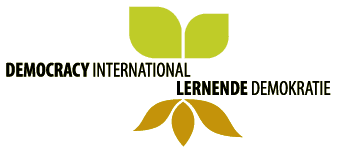Problem-solving processes are often depicted as cycles. The cycle represents typical phases of a democratic participation process that
are worth keeping in mind. The waterline in the symbol of the iceberg reflects the fact that the largest (and most critical) part lies below
the surface and often remains unseen in our democracy.
Structure: Every political process begins and ends with a decision: At the start, an individual chooses to bring a private concern or dissatisfaction into the public sphere (left arrow). The dissatisfaction only subsides when the prevailing impression is that the issue has been resolved (tip of the right arrow). There are two core processes: the left arrow represents the preliminary participation process, and the right arrow represents the subsequent participation process. At the top, near the § symbol, the two meet because, regardless of how much time was spent activating, informing, consulting, and formulating proposals together, a collectively binding decision (in parliament or via referendum) is required before implementation can proceed (right arrow). Even during implementation, participation can and should play a role, for example, in specifying and breaking down the decisions into actionable plans that can be implemented collaboratively. Finally, joint evaluation helps ensure that the implementation is sustainably satisfactory.
There is also an inner circle beneath the “waterline.” This represents informal forms of participation, which do not aim to regulate matters formally through laws or ordinances but involve addressing issues through civil society initiatives. Civic engagement and citizen participation are essentially the same. However, participation is often narrowly defined as influencing decision-makers in politics and administration – the visible tip of the iceberg. A vibrant and strong democracy, however, rests on the many shoulders of active citizens and is supported by participation and engagement that occurs daily, at a grassroots level, across all levels and social milieus. You can use this canvas to situate your project. Where do you want to exert influence? How far do you want to go? Alternatively, you can use it to plan your own participation process – for every phase, there is a wide variety of participation methods available. It is helpful to know where in the cycle you want to engage and have your voice heard.
Process Suggestions for the Participation Cycle
The following list provides just 1-2 suggestions from the vast array of well-known and innovative methods and formats for involving citizens in the political problem-solving cycle. For more information, additional collections, and links, visit: https://lernende-demokratie.de/en/wirvermitteln/.
- Activating, for example through activating surveys or advocacy planning. These involve direct engagement to gather opinions and promote participation. Use: Before participation processes. Another example is online petitions, which collect signatures to bring an issue to parliamentary attention. Use: Agenda setting.
- Informing,for example through neighborhood conferences or city portals. These enable early and open multi-channel communication to inform citizens about measures. Use: At the beginning or end of projects.
- Consulting,for example through hearings with experts or affected parties to gather expertise and perspectives. Use: As a basis for decisions. Another example is future workshops, where ideas and solutions are developed collaboratively. Use: Strategic planning. Design Thinking is also an option, involving co-creative solution development.
- Formulating,for example through planning cells or citizens’ assemblies, which generate specific recommendations through a representative citizen jury. Use: Construction and planning projects. Another example is city conferences, which enable broad participation to develop future scenarios. Use: Topics like traffic or urban development. House parliaments, which advise elected representatives, are particularly useful for sensitive decisions.
- Deciding, for example through mediation rounds to resolve conflicts through mediation. Use: Disputes between residents or institutions. Another example is citizen referenda, which involve direct democratic voting. Use: Currently limited to local and state levels.
- Specifying,for example through participatory budgets, which allocate budget items to specific civic projects. Use: Financing specific civic
projects. Another example is agenda advisory boards, which are fixed intersectoral advisory committees. Use: Local Agenda 21.
Projekte), Agendabeirat (festes intersektorales Beratungsgremium. Einsatz: Lokale Agenda 21). - Planning,for example through implementation circles, which adapt measures to local needs. Use: Large-scale projects like construction. Another example is mixed citizen offices, which combine civil society and administrative input. Use: Projects with intersectoral approaches.
- Implementing,for example through agile project or neighborhood councils, where elected, randomly selected, and delegated representatives moderate implementation in collaboration with the administration. Use: Land consolidation, urban renewal, inclusion networks, etc.
- Evaluating,for example through democracy audits, which are annual transsectoral participation processes to review how well the city or community has developed. Use: Validating the relevance of guiding principles and sustainability strategies.
- Engaging,for example through engagement offices, which are mixed offices for civic engagement. Use: Volunteer exchanges, association conferences. Other options include Open Space, Art of Hosting, and World Café, which invite citizens to take initiative and act themselves.
You can find the German Canvas here.
You can find the English Canvas here.
You can find the Spanish Canvas here.

